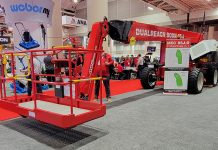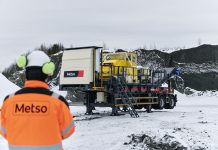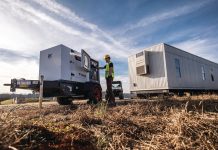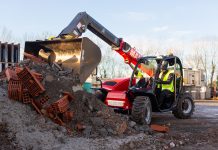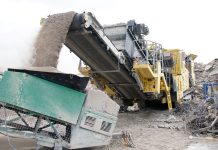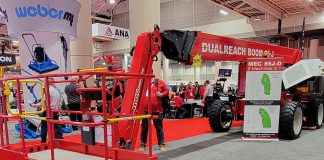Simex is aiming to reduce the manual labour often required when milling around manholes.
With the introduction of the boom-mounted planers MHB 300 and MHB 350, Simex has created an effective response to milling around circular manholes.
The Italian manufacturer introduced the planers at bauma 2019 in Munich, Germany, alongside a new wheel saw model.
When milling pavement, especially in urban settings, round manholes are often an obstacle that generally requires manual intervention. Not even planers of the PL series can mill around the edges of circular manholes to remove the layer of asphalt.
The problem is usually and partially solved by performing milling on four sides, by repositioning the prime mover and attachment four times, but this inevitably means that someone has to intervene manually to remove the layer of asphalt or concrete left in the corners.
This operation, if repeated several times as is necessary when the road contains many manholes, predictably leads to a job slowdown and can impact profitability.
The MHB boom-mounted planers feature a slewing ring joined with a pivot that is connected to a centering system to adjust to the width of the manhole. After the manhole is opened and the cover is removed, the centering system is set down on the inside edge, at which point the operator, after regulating the depth, can begin milling.
The operator can also set the speed as attachment rotates around the manhole.
The MHB planers are available in two models, both of which can mill manholes with a 70 to 130 cm diameter. However, the MHB 300 has a milling width of 30 cm with a depth ranging from 0 to 10 cm, whereas the MHB 350 offers a milling width up to 35 cm and can operate at a 0 to 12 cm depth.
Both models are equipped with 360-degree hydraulic adjustment with adjustable speed, hydraulic depth adjustment and a vertical damping system.

Simex wheel saw range expanded
Since 1995, Simex has produced more than 7,500 wheel saw attachments.
The range of Simex wheel saws currently covers requirements for trenching widths from 30 to 250 mm and depths down to 80 cm.
The Simex saws are designed to cut a clean and precise trench that won’t damage the adjacent pavement, which avoids degrading the excavated material and consequently the mechanical characteristics of the backfill.
The new RWS 400 was designed to meet the need for making cuts with a minimum curve radius of 5 metres. Thanks to a steering system controlled by the operator, the RWS 400 can quickly perform a precise cut and do it in less time as well.
The wheel saw does not have to be repetitively taken out of the trench and repositioned to make the trench in segments. Instead, it follows the curved shape of the road. It creates the trench according to the specific requirements of the project.
With the introduction of the new RWS 400, the RW range now comprises of three different models (RW 500, RWA 500, RWS 400) that cover a broad spectrum of applications.
Designed for cutting and set-section trenching of various types, these wheel saws are ideal for creating trenches and mini-trenches for the installation of fiber optic networks.
The three models have common characteristics that make them reliable and capable of achieving a high productivity and flexibility when excavating asphalt and concrete surfaces, as well as rocky surfaces.
Like the other wheel excavators of the RW series, the RWS 400 features hydraulic piston motors in direct drive with the wheel, which permits high efficiency in addition to high cutting force. Due to the self-levelling system, the operator is free from concerns about poor visibility of the work area, as the depth is programmed before starting work.
You may also like:
- The new generation of MB Crusher shafts screeners
- The Bomag BW 151 AD-5: fatigue-free operation
- Adams #10 road grader at work in Nova Scotia
Another important characteristic of the RW series are the outlets for material discharge, which produce a clean trench at the set depth without the need for a scraper, a solution that also benefits the light weight of the attachment. The excavated material exits either at right and left, but if needed can be conveyed to one side only by closing off one of the outlets. This option proves useful when trenching at roadsides, near sidewalks and flush against walls.
To collect and transport waste material, the wheel saws can be fitted with a frontal conveyor belt that allows the material to be loaded onto a bucket of a second machine. Whereas by closing the side outlets at the front, they can be fitted with a connector for a suction pipe to be attached to a large vacuum. The system is easily disassembled and allows the machine to rapidly return to its configuration with the side discharge.
Another important feature of the wheel saws in the RW series is the standard disk with removable and interchangeable segments, which enable a rapid adjustment of the trench width without the need to replace the entire element, and avoid the extended time this involves.
Last, the total protection of the wheel at any working depth guarantees the maximum safety to people and property by protecting them from any expulsion of material. The RWA 500 — where A stands for angle — is characterized by a hydraulic system that allows the attachment to be placed at an inclination in order to compensate for any tilting of the machine up to a difference in level of 20 cm, and to position the cutting disk perpendicular to the surface to be excavated.


